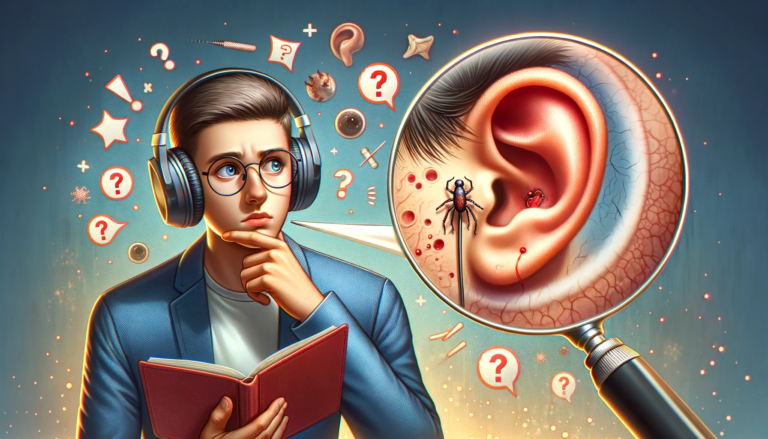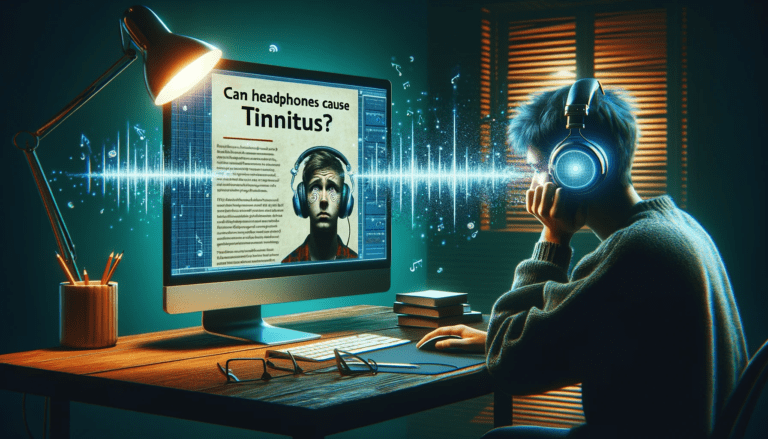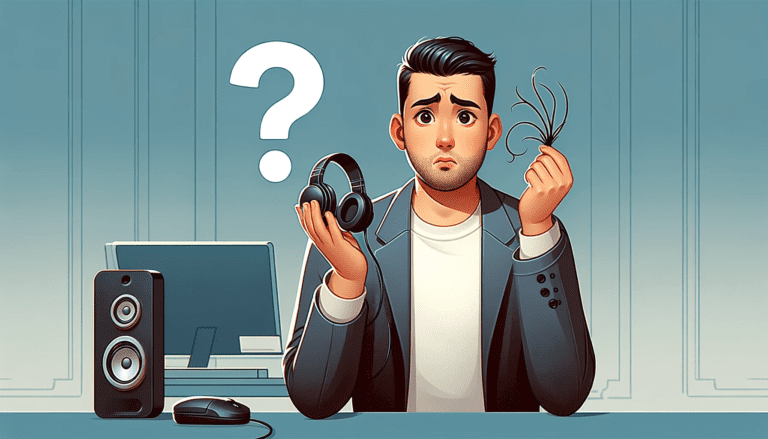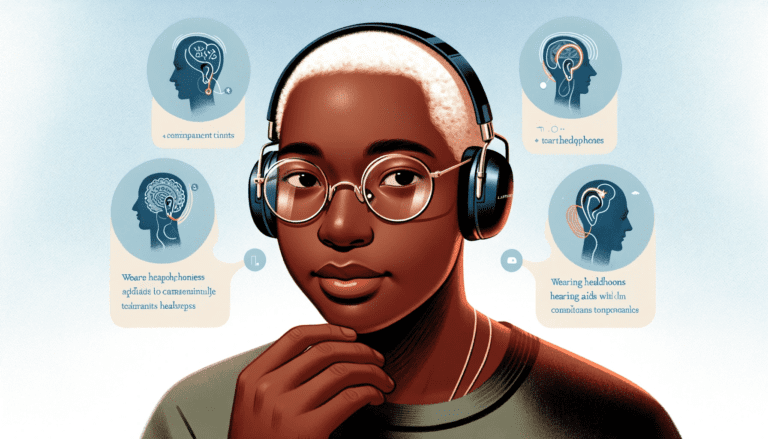Have you ever found yourself reaching for aspirin after a long session with your noise-canceling headphones? This common dilemma sparks an important question: Can these modern audio devices cause headaches? As we increasingly rely on technology for both work and leisure, understanding the impact of these gadgets on our health is more crucial than ever.
The short answer is yes, noise-canceling headphones can potentially cause headaches in some individuals. This is primarily due to the way active noise cancellation technology functions, creating an artificial sense of pressure in the ears that can lead to discomfort and headaches, especially in those sensitive to such sensations. It’s a startling revelation for many who view these devices as a harmless escape from the noisy world around them.
However, understanding this issue requires a deeper dive into the science behind noise-canceling technology and its physiological effects. Let’s explore how these headphones work, why they might lead to headaches, and what can be done to mitigate this issue. With insights from audio experts and health professionals, we’ll unravel this complex topic, ensuring your audio experience remains both immersive and comfortable.
Definition and Purpose of Noise-Canceling Headphones
Before we dive deeper, let’s clarify what noise-canceling headphones are all about. Unlike regular headphones that rely solely on passive insulation to reduce background noises, noise-canceling headphones employ advanced technology to actively counteract unwanted sounds.
They achieve this by using built-in microphones that capture ambient sounds and generate sound waves that are 180 degrees out of phase with those noises. When these anti-noise signals combine with external sounds in our ears, they cancel each other out, giving us a peaceful auditory experience.
The primary purpose of noise-canceling headphones is to create an oasis of serenity for individuals who crave solace from loud environments such as bustling city streets or noisy airplane cabins. Whether you’re an avid traveler seeking respite during long flights or someone who wants to focus deeply on their work in a bustling coffee shop, these headphones provide a shield against distractions and help you maintain your auditory sanity.
Growing Popularity and Usage of These Headphones
Noise-canceling headphones have gained immense popularity over recent years due to their ability to enhance our listening experiences and provide much-needed relief from the chaotic world around us. The demand for these innovative devices has skyrocketed as people increasingly recognize their benefits.
With the rise of remote work and the need to create productive home environments, noise-canceling headphones have become an essential tool for many professionals. These headphones allow individuals to tune out background sounds, enabling them to concentrate more effectively on their tasks and achieve optimal productivity.
Beyond the realm of work, noise-canceling headphones have also found favor among music enthusiasts who crave an immersive audio experience. The ability to block out external disturbances enables listeners to enjoy their favorite tracks with finer details and nuance that might otherwise go unnoticed amidst a sea of ambient noise.
Moreover, noise-canceling headphones have become sought-after companions for frequent travelers. Whether it’s a long flight or a train journey, these headphones provide travelers with a haven of tranquility, transforming noisy commutes into peaceful escapes where they can unwind or catch up on some much-needed rest.
Now that we have established what noise-canceling headphones are and why they have become so popular, let’s delve deeper into the question at hand: Can these technological marvels cause headaches? Join us as we explore the potential causes and remedies for this conundrum. You may read also Are Beats Headphones Good for Big Heads
Explanation of Active Noise Cancellation
Active noise cancellation is a marvelous technological innovation that has revolutionized the way we experience sound. Unlike passive noise isolation, which relies on physical barriers to block out external noises, active noise cancellation actively works to neutralize unwanted sounds. It functions by capturing external sounds, generating anti-noise signals, and delivering canceling sound waves through the headphones.
The Components Involved in the Process
To better understand how active noise cancellation works, let’s delve into its various components. These ingenious devices combine cutting-edge technology and intricate engineering to create a tranquil listening environment amidst a cacophony of noises.
Microphones for Capturing External Sounds
The first crucial element in this process is the implementation of microphones. These tiny devices play a pivotal role by capturing ambient noises from your surroundings. Positioned carefully on the headphones’ exterior or within the ear cups, they ensure that all incoming audio information is collected accurately and in real time.
Digital Signal Processing for Generating Anti-Noise Signals
The captured sounds then undergo an impressive feat of digital signal processing (DSP). This advanced technology processes the audio data received from the microphones and analyzes it meticulously. By identifying specific frequencies and patterns associated with unwanted noise, DSP generates corresponding anti-noise signals to counteract these disturbances.
Speakers for Delivering Canceling Sound Waves
Once the anti-noise signals are appropriately generated through DSP, they are seamlessly transmitted to specialized speakers within the headphones. These speakers work harmoniously with your audio source by emitting canceling sound waves that blend with your desired audio content while silencing extraneous background noises simultaneously.
By combining microphones, digital signal processing, and speakers in an intricately designed system, noise-canceling headphones effectively combat external noises, allowing you to immerse yourself in your music, podcasts, or audiobooks without disruption. It’s truly a remarkable technological achievement that elevates our auditory experiences to new heights.
Benefits of Noise-Canceling Headphones
Enhanced listening experience in noisy environments
When it comes to immersing yourself in your favorite music or podcast, there’s nothing worse than being constantly interrupted by the hustle and bustle of a busy environment. This is where noise-canceling headphones come to the rescue!
With their advanced technology, these headphones can effectively block out external noises, allowing you to enjoy your audio content without distractions. Whether you’re traveling on a noisy airplane or sitting in a crowded café, noise-canceling headphones create a serene auditory bubble around you, ensuring that you catch every beat and lyric with utmost clarity.
But how do they achieve this audio nirvana? Well, noise-canceling headphones use microphones to capture the surrounding sounds and then generate anti-noise signals that cancel out those unwanted noises.
As a result, the external cacophony is greatly reduced or even eliminated. This enhanced listening experience not only allows for better audio quality but also enables you to focus more deeply on the content at hand.
Reduced stress and fatigue caused by excessive noise exposure
Excessive exposure to loud noises can be stressful and exhausting for our minds and bodies. Whether it’s the constant hum of traffic during your daily commute or the incessant chatter in an open office layout, prolonged exposure to such noises can leave you feeling drained and overwhelmed. This is where noise-canceling headphones shine.
By creating a tranquil soundscape amidst chaos, these headphones help reduce stress levels significantly. When wearing noise-canceling headphones, your brain no longer needs to strain itself trying to filter out unwanted sounds from your surroundings.
Instead, it can relax and focus on what truly matters: enjoying your audio content while letting go of any external disturbances. Furthermore, studies have shown that continuous exposure to excessive noise levels can lead to fatigue and cognitive impairments over time.
By shielding your ears from these harmful sounds, noise-canceling headphones can prevent such fatigue-related issues, allowing you to stay energized and mentally sharp throughout the day. So, whether you’re a frequent traveler, an office worker seeking focus in a noisy environment, or simply someone who craves moments of tranquility amidst the chaos of everyday life, noise-canceling headphones offer a valuable solution to enhance your listening experience while simultaneously reducing stress and fatigue caused by excessive noise exposure. You may read the ultimate guide on Are Skullcandy Headphones Good
Potential Causes of Headaches from Noise-Canceling Headphones
Pressure on the ears and head due to tight-fitting design
One of the potential causes of headaches when using noise-canceling headphones is the pressure that the headphones exert on your ears and head. Many noise-canceling headphones come with a snug, tight-fitting design that aims to create an effective seal against external sounds.
While this seal helps in blocking unwanted noises, it can also lead to discomfort and headaches for some individuals. The pressure from the ear cups can press against your temples or jawline, causing tension and strain.
Ear cups exert pressure on the temples or jawline
The ear cups of noise-canceling headphones are designed to enclose your ears fully, creating a sealed environment for optimal noise cancellation. However, this tight fit can sometimes lead to discomfort around your temples or jawline, resulting in headaches.
The prolonged pressure on these areas can lead to tension headaches or even trigger migraines in susceptible individuals. It’s important to ensure that your noise-canceling headphones have sufficient padding and adjustable features to alleviate any excessive pressure points.
Headband tension causing discomfort
Another factor contributing to headaches from noise-canceling headphones is the tension caused by the headband. The headband’s purpose is to hold the headphones securely in place on your head, but if it is too tight or lacks proper cushioning, it can cause discomfort and headaches over time. Continuous pressure from an ill-fitting or overly tense headband can strain your scalp muscles and contribute to headache development.
Sensitivity to low-frequency sounds generated by ANC technology
Active Noise Cancellation (ANC) technology utilized in noise-canceling headphones involves generating anti-noise signals at specific frequencies to counteract external sounds effectively. However, some individuals may be more sensitive to these low-frequency sounds produced by ANC technology, which can lead to headaches.
Infrasound frequencies, specifically those below the audible range of 20 Hz, may affect certain individuals differently and potentially trigger headaches or migraines. This sensitivity can vary from person to person, and it’s essential to be aware of your tolerance levels.
While noise-canceling headphones provide numerous benefits in reducing external noise and enhancing audio experiences, they also have the potential to cause headaches for some users. The tight-fitting design of the ear cups and headband can create pressure points on the temples, jawline, and scalp muscles.
Additionally, sensitivity to low-frequency sounds generated by ANC technology may contribute to headaches in certain individuals. It is crucial to choose headphones with adjustable features and proper padding to alleviate pressure points and consider alternative options if you experience persistent discomfort or headaches when using noise-canceling headphones. You may check also Can You Plug Headphones into a Guitar
Tips to Prevent Headaches While Using Noise-Canceling Headphones
Adjustments to Improve Comfort and Reduce Pressure Points
Finding the perfect fit for your noise-canceling headphones is essential for preventing headaches. Look for headphones with adjustable headbands or ear cups that can be customized to fit your unique head shape.
This way, you can ensure that the pressure is evenly distributed, avoiding any uncomfortable tightness. Remember, a comfortable fit is not just about preventing headaches but also enhancing your overall listening experience.
Additionally, pay attention to how the ear cups rest on your temples or jawline. Some people experience discomfort when the ear cups exert pressure on these areas.
If this happens to you, try adjusting the position of the headphones slightly by tilting them forward or backward until you find a more comfortable spot. It may take a bit of trial and error, but once you discover that sweet spot of comfort, it will make all the difference.
Taking Breaks During Extended Use to Relieve Pressure
While noise-canceling headphones provide an immersive audio experience, it’s crucial not to overdo it. Prolonged use can lead to pressure points building up around your ears and head, potentially causing headaches.
To avoid this, make it a habit to take regular breaks during extended listening sessions. During these breaks, remove your headphones and allow your ears some time to breathe and relax.
Stretching exercises for your neck and shoulders can also help relieve tension in those areas that may contribute to headaches. Use this opportunity to enjoy some silence or engage in other activities that don’t require wearing headphones—your ears will thank you!
Setting Volume Levels Appropriately to Avoid Overstimulation
Another factor that can contribute to headphone-induced headaches is excessively loud volume levels. While noise-canceling technology eliminates background noises, it’s important not to compensate by cranking up the volume too high.
Overstimulation from loud sounds can strain your ears and result in headaches. When using noise-canceling headphones, set the volume at a comfortable level that allows you to hear your audio clearly without needing to raise your voice or strain to listen.
If you find yourself tempted to increase the volume for certain tracks or environments, it might be worth considering whether those headphones are truly suitable for your needs. Remember, protecting your hearing is paramount and will help prevent those pesky headaches from interrupting your enjoyment.
Remember, these tips are not only about preventing headaches but also about ensuring a pleasant listening experience with noise-canceling headphones. By making adjustments for comfort, taking breaks when needed, and setting appropriate volume levels, you can enjoy the benefits of immersive audio without any nagging headaches spoiling the fun.
Mitigating Potential Health Risks Associated with Noise-Canceling Headphones
Consultation with a medical professional for personalized advice
While noise-canceling headphones can greatly enhance our auditory experience, it’s important to remember that each individual’s physiology and health may differ. If you frequently experience headaches or any other discomfort while using noise-canceling headphones, it is advisable to consult with a medical professional.
They can provide personalized advice based on your specific situation and help determine the underlying cause of your symptoms. A medical professional will be able to assess whether your headaches are directly related to the use of noise-canceling headphones or if they may be caused by other factors such as an underlying health condition.
They can evaluate any potential risk factors and consider whether you are particularly sensitive to certain sound frequencies or if any physiological issues may be exacerbated by using these headphones. By seeking expert guidance, you can gain a better understanding of how to mitigate the risks and find potential solutions for headache prevention.
Alternative headphone options that provide passive noise isolation
If you find that noise-canceling headphones still cause headaches despite making adjustments and seeking medical advice, there are alternative options available that provide passive noise isolation. Unlike active noise cancellation technology used in some headphones, passive noise isolation relies on physical barriers like ear cup design and materials to block out external sounds.
One popular alternative is over-ear headphones with closed-back designs. These headphones have sealed ear cups that naturally create a physical barrier between your ears and ambient noises, reducing the need for active sound cancelation technology.
This type of headphone creates an acoustic seal around your ears, effectively isolating you from most external sounds without relying on electronic processes. Another option is in-ear monitors (IEMs) or earbuds specifically designed with passive noise isolation in mind.
These devices come equipped with different sizes of silicone or foam tips that fit snugly into the ear canal, blocking out external sounds. By choosing the right size and type of tips, you can achieve a comfortable fit while minimizing noise leakage and maximizing noise isolation.
It’s essential to carefully research and try different headphone options to find what works best for you. Experimenting with different styles and designs can help alleviate potential discomfort and reduce the risk of headaches associated with noise-canceling headphones.
Remember, finding alternative options that provide passive noise isolation may require some trial and error. Individual preferences and anatomical differences will play a significant role in determining the most suitable solution for your needs.
If you experience headaches or any discomfort when using noise-canceling headphones, seeking professional medical advice is highly recommended. A medical professional can offer personalized guidance based on your specific circumstances.
Additionally, exploring alternative headphone options that provide passive noise isolation may be beneficial in mitigating potential health risks associated with noise-canceling headphones. Remember to prioritize your comfort and overall well-being when selecting the right headphones for you.
Conclusion
In conclusion, while noise-canceling headphones are an innovative technology offering significant benefits in reducing ambient noise, they are not without potential drawbacks. For some users, the active noise-canceling mechanism may lead to sensations of pressure or ear fullness, possibly culminating in headaches. This is not a universal experience, however, and many individuals use these headphones without any discomfort.
Factors such as fit, weight, and individual sensitivity to pressure changes play a crucial role in determining whether these headphones will cause headaches. Therefore, it is advisable for users, especially those prone to headaches or sensitive to pressure changes, to carefully consider these aspects when selecting and using noise-canceling headphones. Ultimately, the priority should be personal comfort and health







